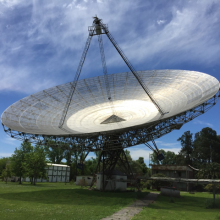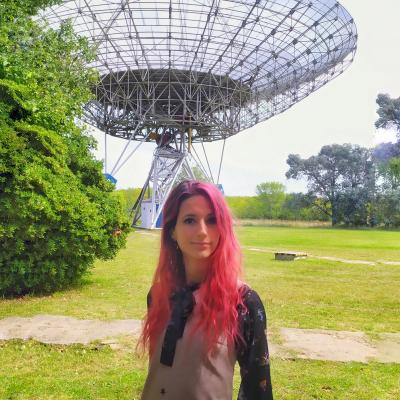
Pulsar timing arrays aim to detect and characterize low-frequency gravitational waves. We are poised to detect gravitational waves from an ensemble of unresolved supermassive black hole binaries (SMBHBs), the "stochastic background'', in the next 3-5 years using an array of precisely-timed millisecond pulsars. As we move towards regular observations of gravitational waves, we plan to detect single "continuous waves'' from SMBHBs, and along with their electromagnetic counterparts, utilize multi-messenger astronomy to push our understanding of the astrophysics of these sources.
The Argentine Institute of Radio Astronomy (IAR) has refurbished two 30-m telescopes for the purpose of pulsar-timing-array observations, with the first telescope already undergoing preliminary observations in March 2018. IAR can see a single, extremely bright millisecond pulsar, PSR J0437--4715, and observations of this pulsar are projected to increase the sensitivity in NANOGrav's "blind spot'' by a factor of 2–3 to different SMBHB systems, thus bridging the gap in our overall sky coverage, and providing sensitivity to a number of potential detectable SMBHB host galaxies. IAR can currently perform daily, four-hour observations of the pulsar, at 1400 MHz.
Multi-messenger astrophysics has been highlighted as one of the NSF's 10 Big Ideas. This proposal enables that science, with a large return for low risk and low cost. In this proposal, we plan to
- Acquire a dedicated storage machine with modules of Nx72TB (in a raid 6 array configuration) for uploading (through fast protocols, like globus) systematic pulsar observations at IAR,
- Install software for remote station observations and post-processing of raw data.
- Greatly increase the sensitivity of NANOGrav's sensitivity to gravitational waves in its "blind spot'' covering half the sky, with the inclusion of observations of PSR J0437--4715.
- Daily observations of Vela Pulsar enabling studies of glitches on short to long timescales,
- Raw data mining searching for Fast-Radio-Burst (FRB) with machine learning algorithms,
- Follow up of Magnetars in the souther hemisphere,
- Study of the short term (daily to hourly) interstellar scintillation.
Our team has expertise in managing large computational facilities (CCRG Lab) for full numerical simulations of GW sources and we will work closely with colleagues at the IAR to enable this high-precision pulsar timing observations, pulsar noise modeling, gravitational-wave analyses, and cyber-infrastructure developments.


